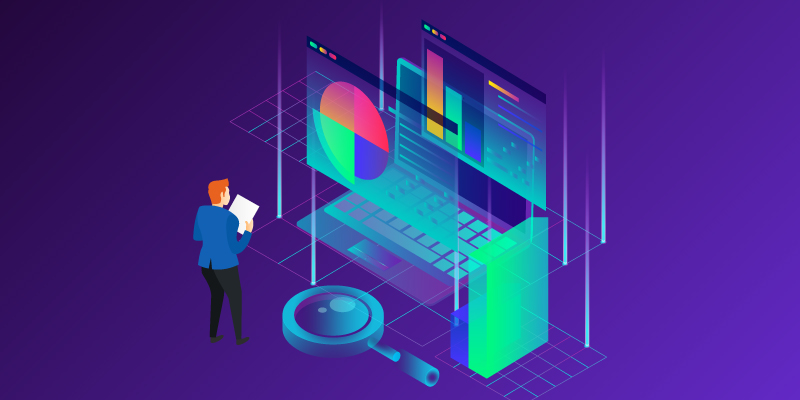
Why choose programming with R for your data science project?
Data science is an exciting mashup of many fields- science, math, statistics, computer science, business intelligence. In recent days, this ever-growing list has grown to add ML and AI. An important part of this is R, a statistical programming language. //Quote "A language that doesn't affect the way you think about programming is not worth knowing." R is definitely that language that will have an impact on your thinking. In this blog, we'll see why a lot of data scientists swear by R. We will also touch upon the data science tools in R that will help you work better.
Read more: Data science tutorial: The complete guide for beginners.
The R is a beautiful language created by two people at the University of Auckland, New Zealand as a platform for handling statistics. It is open-source software and has grown over a period of more than a decade. With the contribution of many, it has turned into one of the most widely used languages for data science. In recent days, one always gets this question posed to them- Should I learn Python or R for data science?
Every language has its set of pros and cons and it is never easy to point one as superior to another. There are instances where data scientists love Python and then some cases where R is preferable.  //quote "Think twice, code once." Python advocates claim that it is more popular and approachable than R. R supporters put forth that this is a language that is specifically meant for dealing with this type of work and is therefore preferable. As far as which language to use is concerned, there are many factors that come into play. Along with the matter of expertise and convenience, it is also a requirement of the data scientist whether to choose R or Python.
//quote "Think twice, code once." Python advocates claim that it is more popular and approachable than R. R supporters put forth that this is a language that is specifically meant for dealing with this type of work and is therefore preferable. As far as which language to use is concerned, there are many factors that come into play. Along with the matter of expertise and convenience, it is also a requirement of the data scientist whether to choose R or Python.
We do offer an online course on Python and you can sign up if you wish to learn it. Let's talk some about R. It was promoted as a statistical platform in its initial days.
So what has changed? What can we say R is today? R has become multifaceted and let's see some of them. Programming language- It is Object-oriented in nature and has objects, operator and functions etc., You can code to explore and model data. Statistical Analysis environment- It was introduced first for such a purpose and plays a pivotal role in most research and predictive modelling. Data analysis software- This is a tool that is preferred for statistics based operations and as such is used for data analysis. predictive modelling and data visualization.
R has a very strong community and they offer a wide variety of packages as add-ons. Some of the popular packages include packages to run SQL on R, use supervised and unsupervised Machine Learning on R, database drivers to access databases, and much additional functionality. R though initially developed by two academicians had found the favour of academia and the leadership group has expanded to include world-renowned scientists and academicians who contribute to its growth. It also has an active Stack overflow group.
Is it easy to learn R?
This again depends on you. The one thing you should not forget about R is that it was never intended as a general-purpose language and was meant for statistical computing and graphics. T
he next thing that makes a difference is the experience. If you are a newbie to the world of coding, you will definitely find it hard to learn and will assume that it has a steep learning curve.
But if you are an experienced coder, then you won't be struggling with it. You will find it easy to learn. Either way, the internet has a wealth of resources and there are online courses that you can take to learn this language. If you are looking for an online course on data science or maybe an offline course on data science, those are also available and rather than studying just one language, you can get certified as a data scientist with Crampete.

Why choose R for your data science project?
We know that the programming language is chosen based on project requirements. Here is a list of reasons why R might be a great choice for your data science project!
Availability R is an open source language which means it is available for free. This in turn emphasizes that R is a great cost-effective solution for data science projects at any scale- small or big. The developer community for R is huge and the development happen at a very fast pace. The contributors also create packages which are additional for R and can be used for various purposes including machine learning. It also leads to the inference that there are a lot of R developers available and is it easier to hire them.
R is popular in general and is still undergoing regular updates and evolving. You can use R to achieve a spectrum of techniques that are statistical as well as graphical. It is easy to learn and is a preferable choice where heavy statistics dependency is present. This makes R a very suitable and a good choice of programming language for any and all data science projects. Popularity in
Academia R is a language by academicians and was meant for students and other academicians. So, it is no wonder that the academicians have taken to this language like fish takes to water. In fact, its popularity in the ratified academic circle is so huge that its leadership grew from 2 to many more. These leadership and contributors also include many eminent scientists. Additionally, a lot of popular books on data science expound the R language.
It is the language of choice for researchers and scholars who are experimenting with data science. There are many books that can be sourced as learning materials to study this language. Its popularity increases with its feature and ease. This is yet another reason why your data science project may need R as the language of choice.
Machine learning There is a misconception that you cannot use ML with R. That's absolutely not true. There are packages offered in R that are meant to use Machine learning concepts in R. Know the differences between machine learning and data science. This is a MUST because at any one stage in every product there is a necessity for automation. There might be a need to train the algorithm for specific functions and for predictive modelling. R makes machine learning approachable and is in this context a great choice for any data science project.
Read more: Data science vs Artificial intelligence: eliminate your doubts
Data wrangling A very important process that is exhausting and time consuming in data science is Data wrangling. It means cleaning up of messy data. The data has to be stored in a convenient setup such that it can be accessed easily when it needs to be analyzed. The R has quite a few impressive packages like data. Table or the dplyr packages that enable us to manipulate the database to wrangle the data.These features are very useful when encountering huge amounts of complex data.
Statistical environment As already mentioned, R is a programming language specifically designed for statistical computing and data configuration.There are a lot of user-created libraries available. These make data analysis a comparatively easy process. It also has extensive documentation. R has a very strong community with expertise in statistics and this gives R an edge over other languages when it comes to data science projects.
Data Visualization In addition to statistical computing, R was also meant for graphics. That is what is data visualization is all about. You need to present the information in graphical form so that any layman who comes across the information is able to understand the result and its impact. Visualization also provides a different perspective to the data being analysed. R has a lot of solid tools that help in analysis, and representation of information. This makes it an attractive choice as a language for your data science project.
Read more: 11 Top Data science skills to get you that job as a data scientist
What are the popular R data science tools?
A lot of data science tools are available. Here, in this section, we are going to explore a few tools and libraries of R that are popular and help you with a wide range of functionality with R. Please note that there is order and these tools are preferences and suggestions.
Dplyr- it is primarily for data manipulation and works around the five functions that are imperative to manipulate data. It can be used on local as well as remote databases.
RStudio- this is an integrated development environment for R. It supports direct execution as well and provides tools for plotting, Rattle- an open source ware and popular data mining tool for R. It is GUI based and presents statistical and visual data. Helps in modelling. A code is generated for your actions which can then be used independently of the environment.
Mlr- The package for machine learning. It has most algorithms for machine learning tasks. It has a variety of features and can run parallel operations.
Esquisse- a GUI package for R. Use effectively for data visualization. Use to draw graphs, plots, export graph or the code written.
DT- wrapper for Data Tables. Used to display matrices and create interactive displays with HTML. It offers many different features like filtering, sorting and more.
RMarkdown- a record keeping package with code in R embedded in it. It allows you to create documents and keep a record of the analysis. It can be used in conjunction with other packages to easily provide web based reports. In conclusion, we can say that R is a good choice to learn considering the demand for use and availability of materials. With a strong community and updates,
R is keeping on its toes and a very compelling argument for R is that it is a language meant for data science than as a general purpose and data science operations are easier on R. And thus, R is a good tool for your data science project. If you are interested in knowing more on data science, visit our blogs section.

Accelerate Your Career with Crampete




